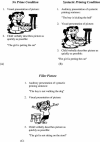Sentence-structure priming in young children who do and do not stutter
- PMID: 15212568
- PMCID: PMC1458370
- DOI: 10.1044/1092-4388(2004/043)
Sentence-structure priming in young children who do and do not stutter
Abstract
The purpose of this study was to use an age-appropriate version of the sentence-structure priming paradigm (e.g., K. Bock, 1990; K. Bock, H. Loebell, and R. Morey, 1992) to assess experimentally the syntactic processing abilities of children who stutter (CWS) and children who do not stutter (CWNS). Participants were 16 CWS and 16 CWNS between the ages of 3;3 (years; months) and 5;5, matched for gender and age (+/-4 months). All participants had speech, language, and hearing development within normal limits, with the exception of stuttering for CWS. All children participated in a sentence-structure priming task where they were shown and asked to describe, on a computer screen, black-on-white line drawings of children, adults, and animals performing activities that could be appropriately described using simple active affirmative declarative (SAAD) sentences (e.g., "The man is walking the dog"). Speech reaction time (SRT) was measured from the onset of the picture presentation to the onset of the child's verbal response in the absence and presence of priming sentences, counterbalanced for order. Main findings indicated that CWS exhibited slower SRTs in the absence of priming sentences and greater syntactic-priming effects than CWNS. These findings suggest that CWS may have difficulty rapidly, efficiently planning and/or retrieving sentence-structure units, difficulties that may contribute to their inabilities to establish fluent speech-language production.
Figures




References
-
- Anderson JD. Sentence-structure priming in normally fluent children: Preliminary findings. Vanderbilt University; 2001. Unpublished manuscript.
-
- Anderson JD, Conture EG. Language abilities of children who stutter: A preliminary study. Journal of Fluency Disorders. 2000;25:283–304. - PubMed
-
- Andrews G, Harris M. The syndrome of stuttering. Heinemann Medical Books; London: 1964.
-
- Au-Yeung J, Howell P. Lexical and syntactic context and stuttering. Clinical Linguistics & Phonetics. 1998;12:67–78.
-
- Bloodstein O. A handbook on stuttering. 5th Singular; San Diego, CA: 1995.
Publication types
MeSH terms
Grants and funding
LinkOut - more resources
Full Text Sources
Medical

